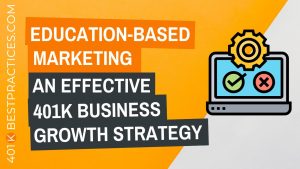Education-Based Marketing – An Effective 401k Business Growth Strategy
Do you want to…
Be seen as the authority?
Win more business?
Eliminate your competition?
You accomplish this through what’s called “Setting the Buying Criteria.” This is an advanced strategy used in conjunction with “Education-Based Marketing.”
Education-Based Marketing Explained
I’m a marketing student in my spare time. I think most entrepreneurs need to be. One of the smartest mentors in the internet marketing space is Joe Polish (Polish is a direct response marketing expert and the president of Piranha Marketing).
One of the key lessons that he teaches is a concept called Education-Based Marketing.
He says you’ll attract more prospects by offering to teach something of value than by trying to sell something.
Prospects want to make informed, intelligent decisions.
When you educate them, power shifts from prospect to seller. That is, the seller becomes a consultant/teacher while setting the buying criteria in their favor.
Prospects also do not have the negative association of feeling sold during the education process.
Setting the Buying Criteria
I was actually first introduced to the concept of setting the buying criteria years ago in David Newman’s book, DO IT! Marketing, 77 Instant-Action Ideas to Boost Sales, Maximize Profits, and Crush Your Competition. (A great book by the way with tons of valuable marketing lessons and ideas.)
He says, in your marketing material, website content, blog, etc., you define what makes a good buying decision. In your definition, you want to make sure that your firm is the only one that fits the definition – this is setting the buying criteria.
You set the buying criteria when you provide valuable education that not only positions you as the authority and a valuable partner, but moves plan sponsors to want to offer a better plan for their employees.
Let’s talk about how you can set the buying criteria…
When you set the buying criteria, you always want to do it in such a way that it excludes your competitors but never bashes or speaks unkindly of your competition.
When all is said and done though, they (your competitors) should NOT qualify based on the criteria you’ve set. This is why the criteria you use should always be exclusive, educational, objective, and client-centered.
A few examples to get you thinking might be:
Five ways manufacturing companies can increase 401k plan participation.
The 3 biggest mistakes made by Medical Practices offering a self-directed account option to their 401k participants.
Attention Plan Sponsors – How hiring a 3(38) investment manager can protect your personal assets from ERISA.
How a documented process can make your DOL audit quick and painless.
Why does this method work so well?
This works because when educating your prospect, you’re seen as someone who can be trusted because you’re letting prospects come to their own conclusions by reading the information and making the connection themselves to how they’re currently operating (which might be against what you said they should be doing).
And this is different than what most advisors do.
Most advisors are talking about themselves and why clients should do business with THEM – and you’re talking about what clients should be looking for and putting the focus on them and their due diligence.
You’re not saying. “Hire us because we are this, that, and the other.”
You’re saying, “When you make a hiring decision, be sure the firm you hire offers this, that, and the other.”
This method of educating and moving prospects along the path of identifying their own plan shortfalls and seeing you as the logical choice is very effective if done correctly.
Remember, the most effective way to position your criteria will always be from an angle that educates and protects the client. You cannot say “7 Reasons to Move Your 401k Plan to Us.”
Don’t Forget the “Why”
When setting the criteria, it’s important to give your prospects a reason WHY.
What I mean by this is when you list out your criteria and position them in a way that appeals to your prospects, you still need to make sure that you are giving your prospects a believable reason why it’s so important.
For example, if you say, “When faced with the choice, plan sponsors are better served to hire a 3(38) investment manager instead of a 3(21) investment advisor,” you need to explain that there is a legal transfer of responsibility and liability in doing this which is a real benefit to plan sponsors.
To Wrap up this Article Series on Effective 401k Prospecting Strategies…
If you want higher conversion rates on the prospects that interact with your firm, you must consistently and systematically apply a prospect and pipeline management system that explains your value, demonstrates your value, and builds authority.
When you meet with prospects, you have to remember that the 401k business is a relationship business and you have to get good at identifying what’s important to your prospects, providing valuable information in bite-sized pieces to move them along a path of building a relationship and creating demand.
And finally, the job of creating trust and demand becomes a lot easier if your content marketing, drip program, and website all provide objective educational information about what plan sponsors should be doing in a way that makes you the only logical choice.
It’s equally as important to be able to answer…
”What value have I added to my prospect’s world in order to continue the conversation and offer my solutions to their problems, headaches, heartaches, and challenges?”
Effective 401k Prospecting Strategies
This article is part of a series covering effective 401k Prospecting Strategies. You can access the full series using the links below:
Listen to the Podcast episode of this topic here (coming soon).Or watch the video on YouTube here (coming soon).
























